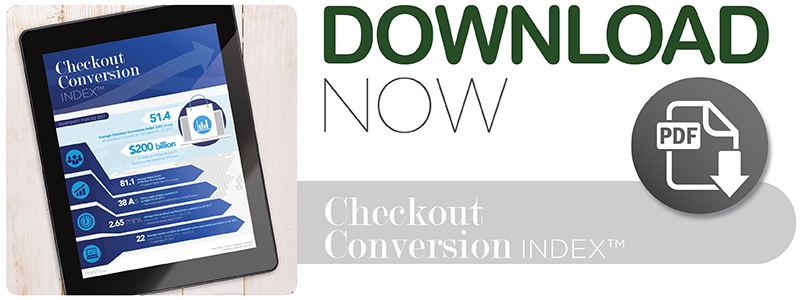NEW DATA: Solving eCom’s $200B Checkout Conversion Problem

Modern consumers want it all: free shipping, live site support, product reviews, many types of payment acceptance and, especially, quick checkout times. If they don’t get what they want, they’re likely to walk — or, well, click — away.
Last year, all those clicking consumers, frustrated by slow and complicated checkout procedures, took $200 billion in potential revenue with them.
The fresh-off-the-presses Checkout Conversion Index™ reveals the set of features that it takes to woo a modern customer. The list includes offering consumers capabilities like an address “same shipping as billing” click box and no onerous profile creation requirements — and that’s just the beginning.
What’s more, top retailers are accepting a wide array of payment types with open arms, an average of 7.6 different payment methods, to be exact.
Of course, some might argue that the wheel of fortune is weighted. Large merchants are often the ones with the money to add customer experience-enhancing features, which, in turn, helps them rake in the revenue to keep adding conversion-winning conveniences and supports.
However, PYMNTS research reveals that micromerchants punched above their weight when it comes to trimming checkout times, beating out larger businesses for website in-and-out speed.
Other key takeaways from the Q2 2017 Checkout Conversion Index™ include:
- eCommerce retail sales last year totaled an estimated 8.6 percent of all retail spending worldwide.
- Top performing merchants received an average Index score of 81.1 out of 100, 37 percent higher than the average Index score of 51.4 out of 100.
- Top performing merchants reduced online purchasing time to an average of 126.8 seconds.
The Q2 2017 Checkout Conversion Index™ features a scoring of the top and lowest scoring merchants, based on performance in reducing customer checkout time and friction. To get the full scoop and data, check out the latest report.
About The Index
The Checkout Conversion Index™ provides a look at what hurts conversion rates and creates friction in the shopping process — just how much money retailers are leaving on the table due to problems with friction and conversion, and why customers are abandoning their online purchases.

